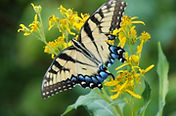American robin (Turdus migratorius)
CONFIRMATION STATUS: Confirmed.
The American robin population in the eastern United States was depleted
in the early 2000s due to the epidemic spread of West Nile virus (intro-
duced into the United States through New York City in the late 1990s).
By 2004 the northern Virginia population of American robin was signifi-
cantly reduced. Fortunately, the disease seems to be less virluent to
American robins as compared to other birds; in particular, the American
crow (100% death rate for infected birds), a species that is found in the
same range throughout much of Virginia, has been more seriously inflicted
the the virus. Unfortunately, the American robin, once infected, lives
longer than other species, helping to spread the disease.
IDENTIFICATION:
-
Length: 8.5 inches
-
Black to dark gray head
-
Broken eye ring
-
Dull red breast and belly
-
White undertail coverts
-
Gray upperparts
-
Streaked throat
-
Thin yellow bill
-
Sexes similar-female somewhat paler
-
Winter plumage is somewhat paler than summer plumage
-
Juveniles have spotted, whiter breasts
-
Common in residential areas where it often forages on lawns
-
Often sings very early in morning
-
Often found in large flocks outside of breeding season
Similar species:
The American robin is a common occupant of residential areas during
the breeding season. In fall and winter, it can be found in large,
somewhat nomadic flocks in areas with lots of fruiting trees. The
very rare rufous-backed robin (southwestern United States) has a
rufous, not gray, back. The varied thrush has a dark band across its
breast and orange wing bars.
LIFE HISTORY
Migration Status: Short distance migrant
Breeding Habitat: Urban
Nest Location: Mid-story/canopy nesting
Nest Type: Open-cup
Clutch Size: 3-4
Length of Incubation: 12-14 days
Days to Fledge: 14-16
Number of Broods: 2, occasionally 3
Diet: Mostly fruit; lesser quantities of insects worms
SKY MEADOWS DISTRIBUTION/SEASONAL OCCURRENCE
Relative abundance and seasonal occurrence are indicated in red below.
Relative abundance
C - Common: Likely to be present in good numbers in appropriate habitat and season.
U - Uncommon: May be present in appropriate habitat and season, often in low
numbers.
O - Occassional: Found in appropriate habitat perhaps only a few times per season,
sometimes low numbers.
R - Rare: May not be recorded every year.
Acc - Accidental: Recorded once or twice, may not be expected again for a long time.
Seasonal Occurrence
Sp - Spring: March, April, May C
Su - Summer: June, July, August C
Fall: September, October, November C
Winter: December, January, February C
Park Activities
Calendar of Events
Volunteer Programs
Sky Meadows Park
Location
Geography
Habitats
Trails
Visiting Park
Crooked Run Valley
Special Projects


